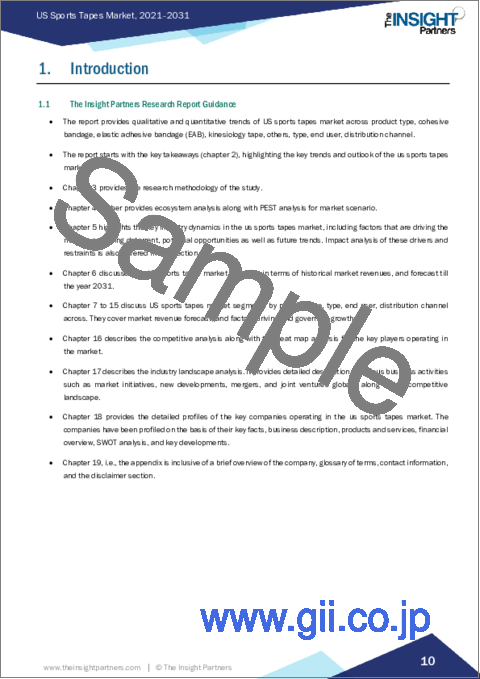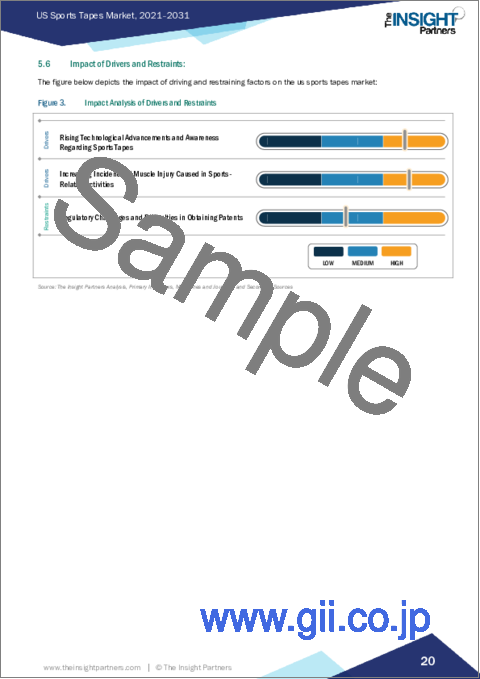|
|
市場調査レポート
商品コード
1509777
米国のスポーツテープ市場:規模・予測、地域別シェア、動向、成長機会分析:製品タイプ別、タイプ別、エンドユーザー別、流通チャネル別US Sports Tapes Market Size and Forecast, Regional Share, Trend, and Growth Opportunity Analysis Report Coverage: By Product Type, Type, End User, Distribution Channel, and Country |
||||||
|
|||||||
| 米国のスポーツテープ市場:規模・予測、地域別シェア、動向、成長機会分析:製品タイプ別、タイプ別、エンドユーザー別、流通チャネル別 |
|
出版日: 2024年06月06日
発行: The Insight Partners
ページ情報: 英文 70 Pages
納期: 即納可能
|
- 全表示
- 概要
- 図表
- 目次
米国のスポーツテープ市場規模は、2023年の7,800万米ドルから2031年には1億5,010万米ドルに成長すると予測されており、2023~2031年のCAGRは8.5%と予測されています。
個人が身体活動、スポーツ、フィットネスに取り組むにつれ、筋緊張、捻挫、その他の軟部組織損傷のリスクが高まっています。このような懸念の高まりを受けて、アスリート、フィットネス愛好家、ヘルスケア専門家は、傷つきやすい筋肉群や関節をサポートし保護する予防策として、スポーツ・テープを利用するようになっています。最高の体調とパフォーマンスを維持することがより重視されるようになり、アスリートはケガのリスクを防ぎ、より早い回復を促すために、スポーツテープをトレーニングレジメンに取り入れています。このように、米国全域でスポーツ関連活動への参加が増えた結果、筋肉損傷の発生率が上昇していることが、米国のスポーツテープ市場規模の拡大を後押ししています。しかし、特許取得や規制要件の遵守における課題が、米国のスポーツテープ市場の成長を抑制しています。
製品タイプ別展望
製品タイプ別に見ると、米国のスポーツテープ市場は粘着包帯、弾性粘着包帯(EAB)、キネシオロジーテープ、プレミアムスポーツテープ/フィジオセラピー、アスレチックテープ、その他に区分されます。キネシオロジーテープ分野は2023年に米国スポーツテープ市場で最も顕著なシェアを占め、2023-2031年の間に市場で最も高いCAGRを記録すると予測されています。キネシオロジーテープ(Kテープ)は、筋肉や関節をサポートし、血行を改善し、痛みや炎症を抑えるためにスポーツ医学で使用される柔軟で通気性のある粘着テープです。従来のアスレチック・テープとは異なり、キネシオロジーテープは人間の皮膚の弾力性を模倣して設計されているため、優しいサポートと安定性を提供しながら、完全な可動域を可能にします。テープ表面のユニークな波のようなパターンは、皮膚をわずかに持ち上げ、皮膚とその下の組織の間に空間を作り、血流とリンパの流れを促進すると考えられています。アスリートは、筋肉痛の緩和、プロプリオセプションの改善、トレーニングや競合時のパフォーマンス向上のために、キネシオロジーテープをよく使用します。さらに、キネシオロジーテープはシャワー中や水泳中でも長時間着用できるため、怪我の管理や回復の最適化を目指すアスリートにとって、多用途で便利なツールとなっています。
Kinesio Holding Corporation、National Spinal Cord Injury Data Sheet、Back Pain Statistics &Factsは、米国のスポーツテープ市場レポート作成時に参照した一次情報および二次情報の一部です。
目次
第1章 イントロダクション
第2章 エグゼクティブサマリー
- 主要な洞察
第3章 調査手法
- 2次調査
- 1次調査
- 仮説の策定
- マクロ経済要因分析
- 基礎数値の作成
- データの三角測量
- 国レベルのデータ
第4章 米国スポーツテープ市場情勢
- PEST分析
第5章 米国のスポーツテープ市場- 主要市場力学
- 米国のスポーツテープ市場:主要市場力学
- 市場促進要因
- スポーツテープに関する技術の進歩と認知度の向上
- スポーツ関連活動による筋肉損傷の増加
- 市場抑制要因
- 規制上の課題と特許取得の難しさ
- 市場機会
- キネシオロジーテープの進化
- 今後の動向
- スマートでコネクテッドなスポーツテープ
- 促進要因と抑制要因の影響
第6章 米国のスポーツテープ市場分析
- 米国のスポーツテープ市場売上高、2021年~2031年
- 米国のスポーツテープ市場の予測・分析
- 米国スポーツ医学市場売上高:2021-2031年
- 米国のスポーツ医学市場の予測・分析
- 米国スポーツ医学市場:タイプ別
- 米国スポーツ医学市場:キャスト別
- 米国スポーツ医学市場:理学療法別
第7章 米国のスポーツテープ市場分析:製品タイプ別
- 粘着包帯
- 伸縮性粘着包帯(EAB)
- キネシオロジーテープ
- プレミアムスポーツテープ/理学療法
- その他
第8章 スポーツテープ市場分析:タイプ別
- 上肢
- 下肢
第9章 米国スポーツテープ市場分析:エンドユーザー別
- 病院
- 動物病院
- 理学療法士およびスポーツリハビリテーション
- アスリート
- その他
第10章 米国スポーツテープ市場分析:流通チャネル別
- 病院薬局
- 小売薬局
- オンライン
- その他
第11章 米国スポーツテープ市場米国のスポーツテープ市場:業界情勢
第12章 企業プロファイル
- Performance Health Holding Inc
- Mueller Sports Medicine
- Howies Athletic Tape
- Essity AB
- Implus Footcare, LLC
- KT Health LLC
- Hampton Adams
- North American Tapes
- Nitto Denko Corp
- THYSOL USA
第13章 企業プロファイル付録
List Of Tables
- Table 1. US Sports Tapes Market Segmentation
- Table 2. US Sports Tapes Market - Revenue and Forecast to 2031 (US$ Million)
- Table 3. US Sports Medicine Market - Revenue and Forecast to 2031 (US$ Million)
- Table 4. US Sports Medicine Market - by Type
- Table 5. US Sports Medicine Market - by Cast
- Table 6. US Sports Medicine Market - by Physiotherapy
- Table 7. US Sports Tapes Market - Revenue and Forecast to 2031 (US$ Million) - by Product Type
- Table 8. US Sports Tapes Market - Revenue and Forecast to 2031 (US$ Million) - by Cohesive Bandage
- Table 9. US Sports Tapes Market - Revenue and Forecast to 2031 (US$ Million) - by Elastic Adhesive Bandage (EAB)
- Table 10. US Sports Tapes Market - Revenue and Forecast to 2031 (US$ Million) - by Kinesiology Tape
- Table 11. US Sports Tapes Market - Revenue and Forecast to 2031 (US$ Million) - by Others
- Table 12. US Sports Tapes Market - Revenue and Forecast to 2031 (US$ Million) - by Type
- Table 13. US Sports Tapes Market - Revenue and Forecast to 2031 (US$ Million) - by End User
- Table 14. US Sports Tapes Market - Revenue and Forecast to 2031 (US$ Million) - by Distribution Channel
- Table 15. Recent Inorganic Growth Strategies in the US Sports Tapes Market
- 1.1.2
List Of Figures
- Figure 1. US Sports Tapes Market Segmentation, by Country
- Figure 2. PEST Analysis
- Figure 3. Impact Analysis of Drivers and Restraints
- Figure 4. US Sports Tapes Market Revenue (US$ Million), 2021-2031
- Figure 5. US Sports Tapes Market Share (%) - by Product Type, 2023 and 2031
- Figure 6. Cohesive Bandage: US Sports Tapes Market- Revenue and Forecast to 2031 (US$ Million)
- Figure 7. Elastic Adhesive Bandage (EAB): US Sports Tapes Market- Revenue and Forecast to 2031 (US$ Million)
- Figure 8. Kinesiology Tape: US Sports Tapes Market- Revenue and Forecast to 2031 (US$ Million)
- Figure 9. Premium Sports Tape/Physiotherapy: US Sports Tapes Market- Revenue and Forecast to 2031 (US$ Million)
- Figure 10. Others: US Sports Tapes Market- Revenue and Forecast to 2031 (US$ Million)
- Figure 11. US Sports Tapes Market Share (%) - by Type, 2023 and 2031
- Figure 12. Upper Extremities: US Sports Tapes Market- Revenue and Forecast to 2031 (US$ Million)
- Figure 13. Lower Extremities: US Sports Tapes Market- Revenue and Forecast to 2031 (US$ Million)
- Figure 14. US Sports Tapes Market Share (%) - by End User, 2023 and 2031
- Figure 15. Hospitals: US Sports Tapes Market- Revenue and Forecast to 2031 (US$ Million)
- Figure 16. Veterinary Clinics: US Sports Tapes Market- Revenue and Forecast to 2031 (US$ Million)
- Figure 17. Physiotherapists and Sports Rehabilitations: US Sports Tapes Market- Revenue and Forecast to 2031 (US$ Million)
- Figure 18. Athletes: US Sports Tapes Market- Revenue and Forecast to 2031 (US$ Million)
- Figure 19. Others: US Sports Tapes Market- Revenue and Forecast to 2031 (US$ Million)
- Figure 20. US Sports Tapes Market Share (%) - by Distribution Channel, 2023 and 2031
- Figure 21. Hospitals Pharmacies: US Sports Tapes Market- Revenue and Forecast to 2031 (US$ Million)
- Figure 22. Retail Pharmacies: US Sports Tapes Market- Revenue and Forecast to 2031 (US$ Million)
- Figure 23. Online: US Sports Tapes Market- Revenue and Forecast to 2031 (US$ Million)
- Figure 24. Others: US Sports Tapes Market- Revenue and Forecast to 2031 (US$ Million)
The US sports tapes market size is expected to grow from US$ 78.00 million in 2023 to US$ 150.10 million by 2031; it is projected to register a CAGR of 8.5% during 2023-2031.
As individuals engage in physical activities, sports, and fitness routines, there is a rising risk of muscle strains, sprains, and other soft tissue injuries. In response to this growing concern, athletes, fitness enthusiasts, and healthcare professionals are increasingly turning to sports tapes as a preventive measure to support and protect vulnerable muscle groups and joints. With a greater emphasis on maintaining peak physical condition and performance, athletes are incorporating sports tapes into their training regimens to prevent the risk of injuries and facilitate faster recovery. Thus, the rising incidence of muscle injuries resulting from the increasing participation in sports-related activities across the US bolsters the expansion of the US sports tapes market size. However, challenges in obtaining patents and compliance with regulatory requirements restrain the US sports tapes market growth.
Product Type -Based Insights
Based on product type, the US sports tapes market is segmented into cohesive bandage, elastic adhesive bandage (EAB), kinesiology tape, premium sports tape/physiotherapy, athletic tape, and others. The kinesiology tape segment held the most prominent US sports tapes market share in 2023 and is expected to register the highest CAGR in the market during 2023-2031. Kinesiology tape, or K-tape, is a flexible and breathable adhesive tape used in sports medicine to support muscles and joints, improve circulation, and reduce pain and inflammation. Unlike traditional athletic tape, kinesiology tape is designed to mimic the elasticity of human skin, allowing for a full range of motion while providing gentle support and stability. The unique wave-like pattern on the tape's surface is thought to lift the skin slightly, creating space between the skin and underlying tissues to promote blood flow and lymphatic drainage. Athletes often use kinesiology tape to alleviate muscle soreness, improve proprioception, and enhance performance during training and competition. Additionally, k-tape can be worn for extended periods, even during showers or swimming, making it a versatile and convenient tool for athletes looking to manage injuries and optimize their recovery.
Kinesio Holding Corporation, National Spinal Cord Injury Data Sheet, and Back Pain Statistics & Facts are among the primary and secondary sources referred to while preparing the US sports tapes market report.
Table Of Contents
1. Introduction
- 1.1 The Insight Partners Research Report Guidance
- 1.2 Market Segmentation
2. Executive Summary
- 2.1 Key Insights
3. Research Methodology
- 3.1 Secondary Research
- 3.2 Primary Research
- 3.2.1 Hypothesis formulation:
- 3.2.2 Macro-economic factor analysis:
- 3.2.3 Developing base number:
- 3.2.4 Data Triangulation:
- 3.2.5 Country level data:
4. US Sports Tapes Market Landscape
- 4.1 Overview
- 4.2 PEST Analysis
5. US Sports Tapes Market - Key Market Dynamics
- 5.1 US Sports Tapes Market - Key Market Dynamics
- 5.2 Market Drivers
- 5.2.1 Rising Technological Advancements and Awareness Regarding Sports Tapes
- 5.2.2 Increasing Incidence of Muscle Injury Caused in Sports-Related Activities
- 5.3 Market Restraints
- 5.3.1 Regulatory Challenges and Difficulties in Obtaining Patents
- 5.4 Market Opportunities
- 5.4.1 Increasing Advancement of Kinesiology Tapes
- 5.5 Future Trends
- 5.5.1 Smart and Connected Sports Tapes
- 5.6 Impact of Drivers and Restraints:
6. US Sports Tapes Market Analysis
- 6.1 US Sports Tapes Market Revenue (US$ Million), 2021-2031
- 6.1.1 US Sports Tapes Market Forecast and Analysis
- 6.2 US Sports Medicine Market Revenue (US$ Million), 2021-2031
- 6.3 US Sports Medicine Market Forecast and Analysis
- 6.4 US Sports Medicine Market, by Type
- 6.5 US Sports Medicine Market, by Cast
- 6.6 US Sports Medicine Market, by Physiotherapy
7. US Sports Tapes Market Analysis - by Product Type
- 7.1 Cohesive Bandage
- 7.1.1 Overview
- 7.1.2 Cohesive Bandage: US Sports Tapes Market - Revenue and Forecast to 2031 (US$ Million)
- 7.2 Elastic Adhesive Bandage (EAB)
- 7.2.1 Overview
- 7.2.2 Elastic Adhesive Bandage (EAB): US Sports Tapes Market - Revenue and Forecast to 2031 (US$ Million)
- 7.3 Kinesiology Tape
- 7.3.1 Overview
- 7.3.2 Kinesiology Tape: US Sports Tapes Market - Revenue and Forecast to 2031 (US$ Million)
- 7.4 Premium Sports Tape/Physiotherapy
- 7.4.1 Overview
- 7.4.2 Premium Sports Tape/Physiotherapy: US Sports Tapes Market - Revenue and Forecast to 2031 (US$ Million)
- 7.5 Others
- 7.5.1 Overview
- 7.5.2 Others: US Sports Tapes Market - Revenue and Forecast to 2031 (US$ Million)
8. Sports Tapes Market Analysis - by Type
- 8.1 Upper Extremities
- 8.1.1 Overview
- 8.1.2 Upper Extremities: US Sports Tapes Market - Revenue and Forecast to 2031 (US$ Million)
- 8.2 Lower Extremities
- 8.2.1 Overview
- 8.2.2 Lower Extremities: US Sports Tapes Market - Revenue and Forecast to 2031 (US$ Million)
9. US Sports Tapes Market Analysis - by End User
- 9.1 Hospitals
- 9.1.1 Overview
- 9.1.2 Hospitals: US Sports Tapes Market - Revenue and Forecast to 2031 (US$ Million)
- 9.2 Veterinary Clinics
- 9.2.1 Overview
- 9.2.2 Veterinary Clinics: US Sports Tapes Market - Revenue and Forecast to 2031 (US$ Million)
- 9.3 Physiotherapists and Sports Rehabilitations
- 9.3.1 Overview
- 9.3.2 Physiotherapists and Sports Rehabilitations: US Sports Tapes Market - Revenue and Forecast to 2031 (US$ Million)
- 9.4 Athletes
- 9.4.1 Overview
- 9.4.2 Athletes: US Sports Tapes Market - Revenue and Forecast to 2031 (US$ Million)
- 9.5 Others
- 9.5.1 Overview
- 9.5.2 Others: US Sports Tapes Market - Revenue and Forecast to 2031 (US$ Million)
10. US Sports Tapes Market Analysis - by Distribution Channel
- 10.1 Hospitals Pharmacies
- 10.1.1 Overview
- 10.1.2 Hospitals Pharmacies: US Sports Tapes Market - Revenue and Forecast to 2031 (US$ Million)
- 10.2 Retail Pharmacies
- 10.2.1 Overview
- 10.2.2 Retail Pharmacies: US Sports Tapes Market - Revenue and Forecast to 2031 (US$ Million)
- 10.3 Online
- 10.3.1 Overview
- 10.3.2 Online: US Sports Tapes Market - Revenue and Forecast to 2031 (US$ Million)
- 10.4 Others
- 10.4.1 Overview
- 10.4.2 Others: US Sports Tapes Market - Revenue and Forecast to 2031 (US$ Million)
11. US Sports Tapes Market - Industry Landscape
- 11.1 Overview
12. Company Profiles
- 12.1 Performance Health Holding Inc
- 12.1.1 Key Facts
- 12.1.2 Business Description
- 12.1.3 Products and Services
- 12.1.4 Financial Overview
- 12.1.5 SWOT Analysis
- 12.1.6 Key Developments
- 12.2 Mueller Sports Medicine
- 12.2.1 Key Facts
- 12.2.2 Business Description
- 12.2.3 Products and Services
- 12.2.4 Financial Overview
- 12.2.5 SWOT Analysis
- 12.2.6 Key Developments
- 12.3 Howies Athletic Tape
- 12.3.1 Key Facts
- 12.3.2 Business Description
- 12.3.3 Products and Services
- 12.3.4 Financial Overview
- 12.3.5 SWOT Analysis
- 12.3.6 Key Developments
- 12.4 Essity AB
- 12.4.1 Key Facts
- 12.4.2 Business Description
- 12.4.3 Products and Services
- 12.4.4 Financial Overview
- 12.4.5 SWOT Analysis
- 12.4.6 Key Developments
- 12.5 Implus Footcare, LLC
- 12.5.1 Key Facts
- 12.5.2 Business Description
- 12.5.3 Products and Services
- 12.5.4 Financial Overview
- 12.5.5 SWOT Analysis
- 12.5.6 Key Developments
- 12.6 KT Health LLC
- 12.6.1 Key Facts
- 12.6.2 Business Description
- 12.6.3 Products and Services
- 12.6.4 Financial Overview
- 12.6.5 SWOT Analysis
- 12.6.6 Key Developments
- 12.7 Hampton Adams
- 12.7.1 Key Facts
- 12.7.2 Business Description
- 12.7.3 Products and Services
- 12.7.4 Financial Overview
- 12.7.5 SWOT Analysis
- 12.7.6 Key Developments
- 12.8 North American Tapes
- 12.8.1 Key Facts
- 12.8.2 Business Description
- 12.8.3 Products and Services
- 12.8.4 Financial Overview
- 12.8.5 SWOT Analysis
- 12.8.6 Key Developments
- 12.9 Nitto Denko Corp
- 12.9.1 Key Facts
- 12.9.2 Business Description
- 12.9.3 Products and Services
- 12.9.4 Financial Overview
- 12.9.5 SWOT Analysis
- 12.9.6 Key Developments
- 12.10 THYSOL USA
- 12.10.1 Key Facts
- 12.10.2 Business Description
- 12.10.3 Products and Services
- 12.10.4 Financial Overview
- 12.10.5 SWOT Analysis
- 12.10.6 Key Developments
13. Appendix
- 13.1 About The Insight Partners
- 1.1.1






